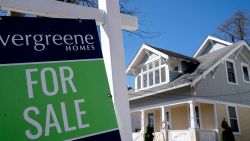The real estate market was on fire last year, with the frenzied pace of sales activity pushing home prices to record highs.
The median home sales price was $346,900 in 2021, up 16.9% from 2020, and the highest on record going back to 1999, according to the National Association of Realtors. Home sales had the strongest year since 2006, with 6.12 million homes sold, up 8.5% from the year before.
While that was bad news for would be buyers, it was a boon for those who already owned a home. A typical homeowner accumulated $50,200 in housing wealth, looking at the median price from 2020 to 2021.
“That is a sizable wealth gain for homeowners across the country,” said Lawrence Yun, NAR’s chief economist. “The housing market has seen a spectacular performance this last year with sales rising and prices rising. But inventory is at an all-time low.”
By the end of 2021, there were fewer homes for sale than ever. The inventory of unsold existing homes fell to a record low of 910,000 at the end of December. That’s a 1.8-month supply of homes at the current pace, also an all-time low.
Yun anticipates total annual home sales to drop a bit in 2022 as mortgage rates tick up. But he added that employment gains, stricter underwriting standards and continued demand are strong indications that the market is not in danger of crashing.
“This year, consumers should prepare to endure some increases in mortgage rates,” Yun cautioned. “I also expect home prices to grow more moderately by 3% to 5% in 2022, and then similarly in 2023 as more supply reaches the market.”
Inventory hits new low
Because of scarce inventory, sales of existing homes – which include single-family homes, townhomes, condominiums and co-ops – dropped 4.6% in December from November, and 7.1% from a year ago.
“December saw sales retreat, but the pullback was more a sign of supply constraints than an indication of a weakened demand for housing,” said Yun.
The low inventory has also knocked down the sales of homes in affordable price ranges.
Home sales in the $100,000 to $250,000 range were down 23.2% in December from the year before. Meanwhile, homes priced between $750,000 and $1 million saw sales rise 32.2% from last year, according to the report.
“The upper end of the market is moving along,” Yun said. “But at the lower end, there is not enough inventory or some homes are being pushed into the higher price brackets.”
More homes are expected to come onto the market during the spring home selling season, Yun said. And good news also came from the Commerce Department on Wednesday that home building grew in December.
“This new supply is clearly needed, as move-up buyers purchasing new homes will free up existing inventory for the wave of first-time buyers,” said Mike Fratantoni, senior vice president and chief economist at the Mortgage Bankers Association. “We continue to expect that 2022 will see growth in home sales, decelerating home-price growth, and a record volume of purchase mortgage originations.”
“Homebuilders have already made strides in 2022 to increase supply, but reversing gaps like the ones we’ve seen recently will take years to correct,” said Yun.
Home prices still climbing
With fewer than one million homes on the market at the end of December, prices continued to climb as buyers raced against the clock to secure low mortgage rates on the homes for sale.
“Even as sales are falling, prices are rising showing that demand is still there,” Yun said.
The median existing home price for all housing types in December was $358,000, which was up 15.8% from a year ago, marking 118 straight months of year-over-year increases, the longest-running streak on record. Prices rose across the country, with the south seeing the biggest appreciation.
In November, the share of first-time buyers fell to just 26% of all buyers. But in December the share of first-time buyers perked back up to 30%.
“There was a significant surge in first-time buyers at the end of the year,” Yun said. “With mortgage rates expected to rise in 2022, it’s likely that a portion of December buyers were intent on avoiding the inevitable rate increases.”


























